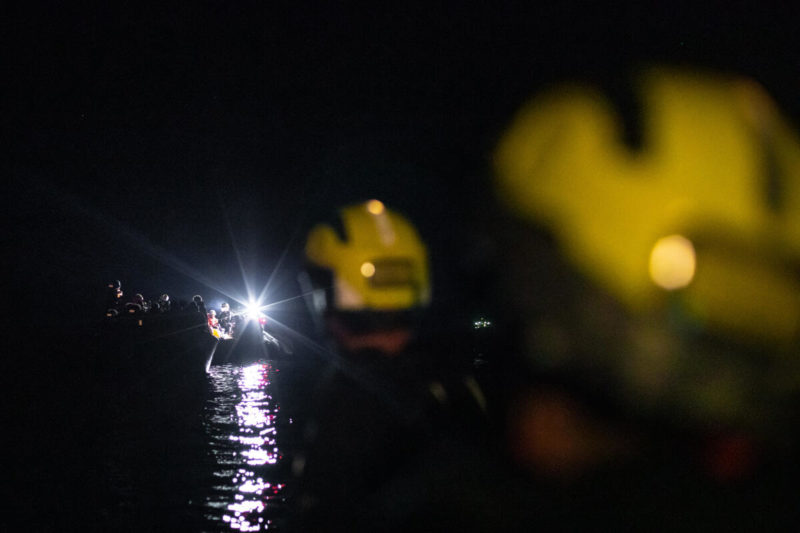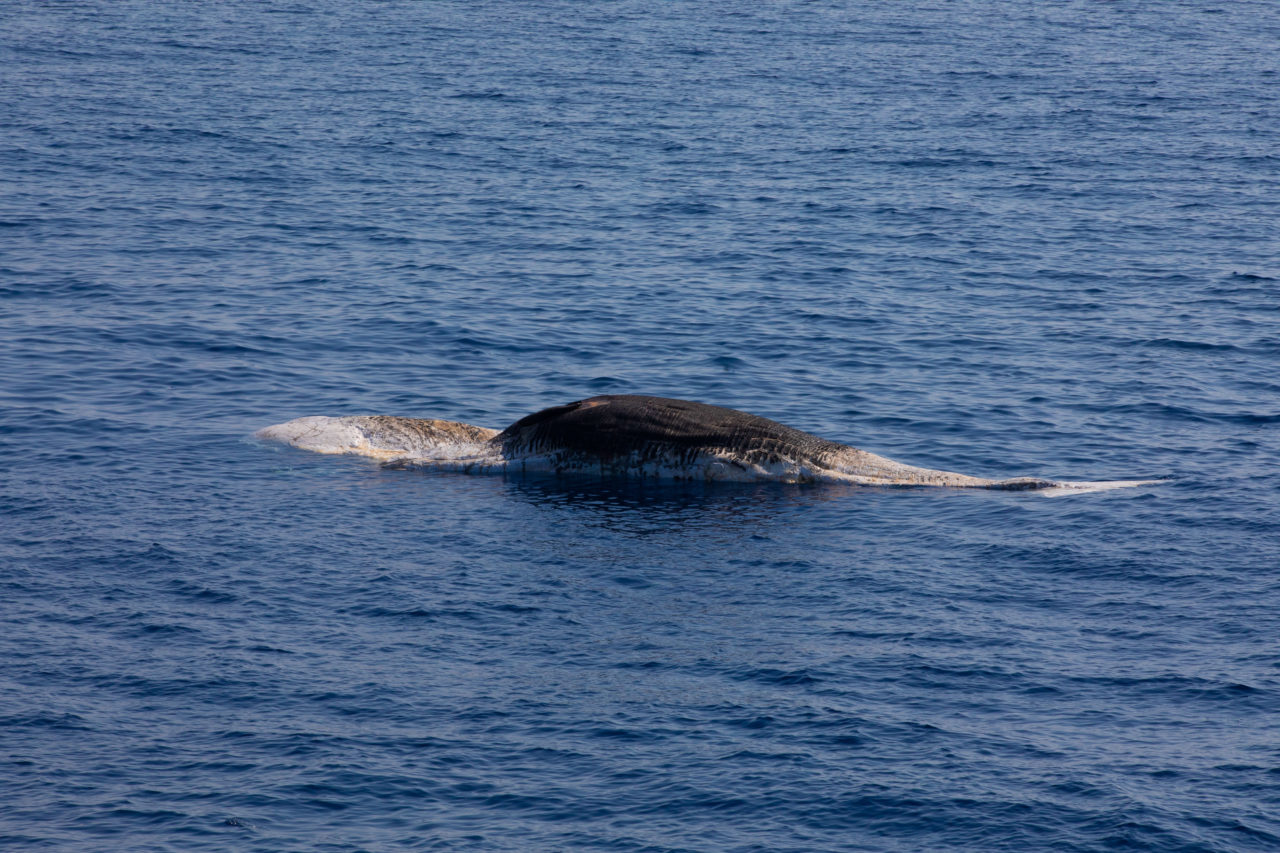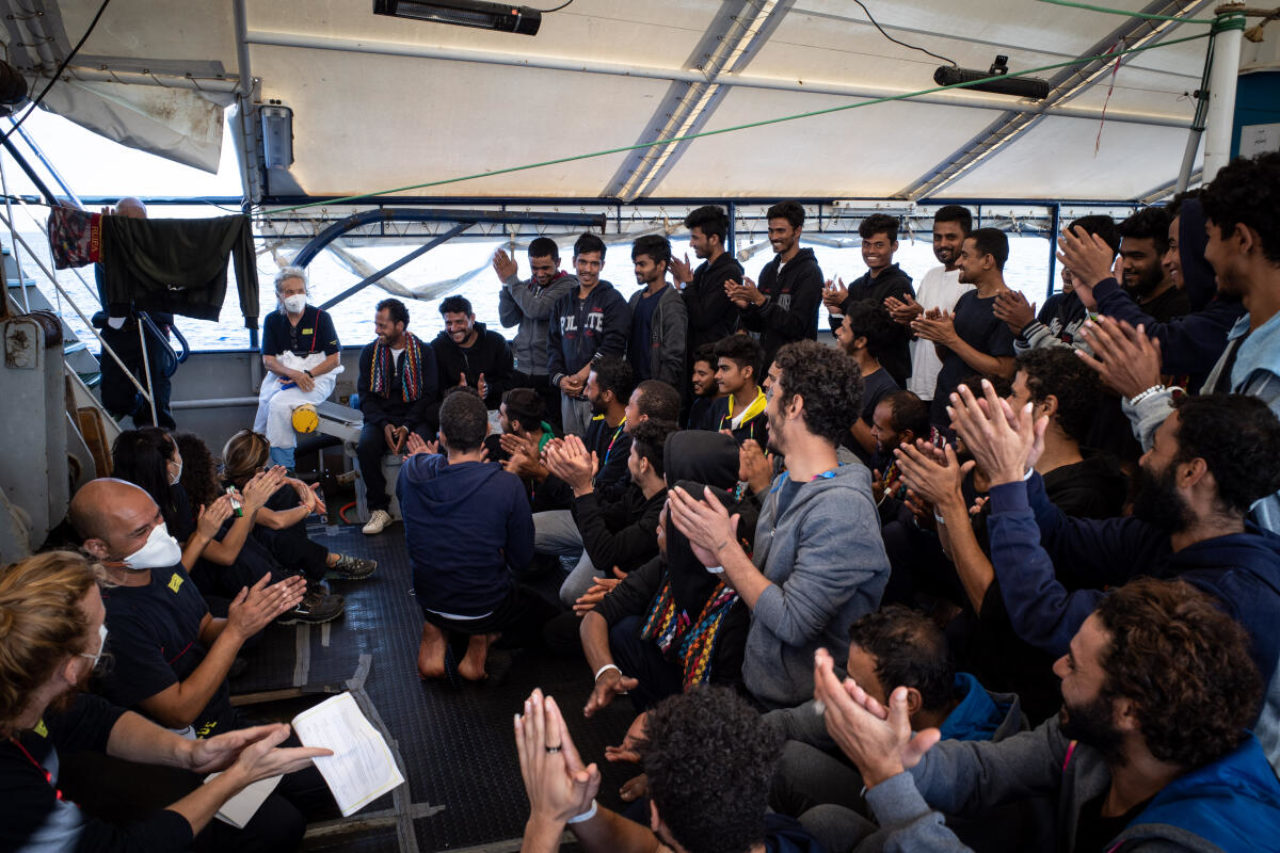Blog from aboard 05

We rescue 45 people from a completely overcrowded wooden boat in darkness. Press officer Petra reports directly from Humanity 1.
Saturday, 22 October 2022, Mediterranean Sea
So far, the October rotation of the Humanity 1, which I am currently joining on board, has been more like a search operation than a rescue operation. However, that was about to change.
After our targeted search for two reported maritime emergencies from Tuesday evening to Thursday remains unsuccessful, the civil emergency hotline Alarm Phone reports another boat in distress on Friday morning: 32 people in a rubber dinghy who have run out of fuel. The position is 240 nautical miles away, that’s about a 24 hour journey. We set course and pick up speed. In the afternoon, we hear how fishermen report a blue boat in distress over the radio, “a lot of people, they need help!” The position given is only 80 nautical miles away, so we set course for this distress at sea at first. Yet the intensive search during the night remains unsuccessful. In the morning, we receive an updated position of the black inflatable boat with 32 people from Alarm Phone. Therefore, we return to the course for this case. A short time later, we learn that the Maltese Maritime Rescue Coordination Centre (MT MRCC) in charge has apparently sent several merchant vessels to the boat in distress. As there is now another emergency call via radio from a fisherman for the blue boat, we continue our search for this distress case, which otherwise won’t get any help.
Late Saturday morning, I am on lookout duty on the top deck. After an hour, I spot a dark, flat object on the horizon through my binoculars that could be a blue boat. I immediately report my observation to the bridge. We sail towards it and assume it is a dinghy. Then it starts: “All crew, all crew, ready for rescue!”, our Search and Rescue Coordinator (SARCo) Dragos instructs over the radio that each of us wears on our bodies. I imagine how quickly I could have missed the dinghy. Suddenly, I feel the huge responsibility of such a lookout service.

In full rescue gear, the rescue crew meets on deck to board the speedboats. But then comes the surprising news: the dinghy turns out to be the bloated carcass of a dead whale, which eventually drifts slowly past our ship.
Only a short time later, Airborne from Sea-Watch report to us that their reconnaissance aircraft Seabird 3 spotted a wooden boat with many people on board. We suspect that it is the boat in distress we were looking for the night before that are are presently searching. Now we receive the updated position which we reach after dark. The crew is quiet, but everyone is wide awake, you can feel concentrated energy. I get on board our speedboat (RHIB) “Bravo” with four rescue crew members and we slowly approach the light of a torch in the darkness and calm seas. Apart from the flashing light, nothing can be seen until we are relatively close and aim our light at the flashing spot. Suddenly, we see a large wooden boat, similar to a sailing ship without a mast. On it, young men are sitting close together, blinking uncertainly into the bright light. Some stand up and shout and wave. No one is wearing a life jacket.
We wave back, drive up slowly, then SARCo Dragos begins his speech: “We are here to help you, we are from Europe!” Shouts in Arabic, then our cultural mediator Fares, who is from Syria, takes over. He tells the people in Arabic to sit still, and explains that we will take them all to our rescue ship, but only when everyone has put on a life jacket. The people respond with no to the question about women, children, and injured people, telling us that they are 45 men from Syria, Bangladesh, and Egypt, among other countries. I quickly pass the life jackets, which we carry in large white bags, to the front. Dragos demonstrates how to put them on. The survivors are cooperative, and also help each other.
Everything is running orderly and well managed. Now, one by one they can get on our speedboat, while the RHIB driver Oriol skillfully keeps the RHIB close to the wooden boat. I stand in the back of our boat, wave person by person to me, show them to sit on the air chamber of the boat, and welcome them in English and Arabic. I get many thumbs up, “thank you”, “shukran”, hand to heart. I smile at them, hoping they can see it in my eyes despite my mouth and nose protection. Some pray, hands to the sky. With 16 survivors we cast off, our second speedboat “Tango” is already waiting a short distance away to take the next ones on board.
Everything runs as routinely as if we had been carrying out rescues every day for weeks. The prior training has really paid off and I notice the experience of my colleagues. Once we arrive at the Humanity 1, which is invitingly lit, many crew members are standing at the railing above and below, waving in a friendly manner, and bosun Samir shouts: “Salam aleikum!” We have to instruct the rescued briefly to remain seated. The landing is a shaky moment during which someone can easily fall overboard. A young man next to me is about to take off his life jacket. I tell him to leave it on until he is on deck. Quickly, they all climb up the ladder one after the other, on the last steps they are pulled up by the hands of two crew members.
Onboard the rescue ship, they are helped out of their life jackets, then they first sit down on the floor, we want to register them calmly. Everyone gets a number, unaccompanied minors and medical cases get a coloured one, and everyone else a neutral one. Fortunately, there are only less severe conditions for our medical team to alleviate: diarrhoea, dehydration, headaches. After everyone has received a blanket and a rescue kit with fresh clothes, they take a shower and brush teeth. Who knows for how long they weren’t able to do so. Then, they receive sweet tea, which is drunk by the litre as the survivors slowly settle down.

Shortly after 01:00 in the morning, during my deck watch with Luca, the volunteer Mental Health Representative, the last of the rescued are able to fall asleep wrapped in their blankets. The next day, the men are going to properly arrive on board with us. They will want to dance to music, involve us, and take lots of selfies with crew members after we have recharged their phones. But at this point in the night, I’m just happy that everything worked out so well.



